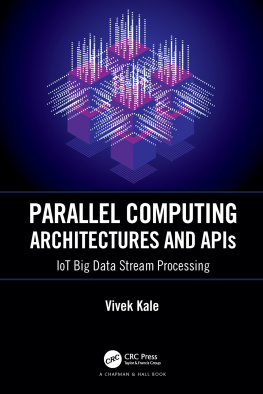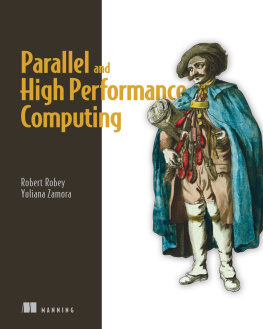Vivek Kale - Parallel Computing Architectures and APIs: IoT Big Data Stream Processing
Here you can read online Vivek Kale - Parallel Computing Architectures and APIs: IoT Big Data Stream Processing full text of the book (entire story) in english for free. Download pdf and epub, get meaning, cover and reviews about this ebook. year: 2020, publisher: CRC Press, genre: Computer / Science. Description of the work, (preface) as well as reviews are available. Best literature library LitArk.com created for fans of good reading and offers a wide selection of genres:
Romance novel
Science fiction
Adventure
Detective
Science
History
Home and family
Prose
Art
Politics
Computer
Non-fiction
Religion
Business
Children
Humor
Choose a favorite category and find really read worthwhile books. Enjoy immersion in the world of imagination, feel the emotions of the characters or learn something new for yourself, make an fascinating discovery.
- Book:Parallel Computing Architectures and APIs: IoT Big Data Stream Processing
- Author:
- Publisher:CRC Press
- Genre:
- Year:2020
- Rating:3 / 5
- Favourites:Add to favourites
- Your mark:
Parallel Computing Architectures and APIs: IoT Big Data Stream Processing: summary, description and annotation
We offer to read an annotation, description, summary or preface (depends on what the author of the book "Parallel Computing Architectures and APIs: IoT Big Data Stream Processing" wrote himself). If you haven't found the necessary information about the book — write in the comments, we will try to find it.
One of the most important reasons for studying parallel computing architectures is to learn how to extract the best performance from parallel systems. Specifically, you must understand its architectures so that you will be able to exploit those architectures during programming via the standardized APIs.
This book would be useful for analysts, designers and developers of high-throughput computing systems essential for big data stream processing emanating from IoT-driven cyber-physical systems (CPS).
This pragmatic book:
Devolves uniprocessors in terms of aladder of abstractionsto ascertain (say) performance characteristics at a particular level of abstraction
Explains limitations of uniprocessor high performance because of Moores Law
Introduces basics of processors, networks and distributed systems
Explains characteristics of parallel systems, parallel computing models and parallel algorithms
Explains the three primary categorical representatives of parallel computing architectures, namely, shared memory, message passing and stream processing
Introduces the three primary categorical representatives of parallel programming APIs, namely, OpenMP, MPI and CUDA
Provides an overview of Internet of Things (IoT), wireless sensor networks (WSN), sensor data processing, Big Data and stream processing
Provides introduction to 5G communications, Edge and Fog computing
Parallel Computing Architectures and APIs: IoT Big Data Stream Processing discusses stream processing that enables the gathering, processing and analysis of high-volume, heterogeneous, continuous Internet of Things (IoT) big data streams, to extract insights and actionable results in real time.Application domains requiring data stream management include military, homeland security, sensor networks, financial applications, network management, web site performance tracking, real-time credit card fraud detection, etc.
Vivek Kale: author's other books
Who wrote Parallel Computing Architectures and APIs: IoT Big Data Stream Processing? Find out the surname, the name of the author of the book and a list of all author's works by series.






